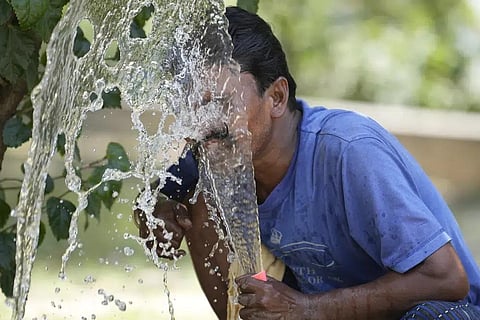Delhi's heat action plan: After approval by 'city government', will be submitted to Centre, say officials
NEW DELHI: Delhi's health and heat action plan to mitigate the impact of extreme heat episodes on vulnerable people in the national capital is ready and will be submitted to the Centre soon, officials have said.
Heat action plans (HAPs) are the primary policy response to economically damaging and life-threatening heat waves.
These prescribe a number of activities, disaster responses and post-heatwave response measures to decrease the impact of heat waves.
Delhi currently does not have a heat action plan with officials saying the administration follows the National Disaster Management Authority's guidelines on extreme heat events.
"The heat action plan is ready. Once it is approved by the city government, it will be submitted to the Centre," an official told PTI.
According to Delhi Disaster Management Authority (DDMA) officials, the Delhi HAP incorporates data on heat-related illnesses from the Integrated Disease Surveillance Programme of the Union Health Ministry.
A vulnerability assessment has been conducted to identify at-risk populations, evaluate adaptive capacity of communities and help develop adaptation strategies, the officials said.
The DDMA has also tasked the Delhi Pollution Control Committee to develop a colour-coded early warning system or a heat alert system to warn people about impending extreme heat conditions in advance, like it is done for air pollution episodes.
Officials, however, did not divulge if the alert system is based only on temperatures or a heat index.
Heat index, also known as the "apparent temperature", is a measure of how hot it feels to the human body when both air temperature and humidity are taken into account.
Sweating is the body's natural mechanism to cool down. When sweat evaporates from the skin, it removes heat from the body, providing a cooling effect.
However, in humid conditions, the air is already saturated with moisture, slowing down or preventing the evaporation of sweat.
Officials said a protocol has also been developed to investigate deaths due to suspected heat strokes.
The Delhi health and heat action plan also focuses on strengthening all healthcare facilities with equipment, staff and medicinal supply to handle potential increases in heat-related illnesses.
It talks about reducing heat exposure through adaptive measures like cool roofing and improving the blue-green infrastructure in the city.
The DDMA has also recommended rest for government and non-government vulnerable occupational groups during peak heat hours of the day and ensuring drinking water supply and round-the-clock electricity, especially on heatwave days.
The India Meteorological Department (IMD) has reported a 24 per cent increase in the number of heat waves during 2010-2019 compared to 2000-2009.
Between 2000 and 2019, the mortality rate for tropical cyclones decreased by 94 per cent whereas it increased by 62.2 per cent for heat waves, the IMD data shows.
The Fifth Assessment Report of the Intergovernmental Panel on Climate Change (IPCC) said the major climate risk for south Asian countries will be the rising mortality rate due to heat waves.
A moderate uptick in average temperatures or a slight rise in the duration of heat waves will lead to a significant increase in the mortality rate in India unless remedial and response measures are taken, the IPCC report said.
However, heat waves are yet to be notified as a natural disaster at the national level.
Heat waves have an immense impact on human health, causing cramps, exhaustion, stress and heat stroke and very severe heat waves even lead to death.
The elderly, children and people with heart and respiratory problems, kidney diseases and psychiatric disorders are particularly affected.
Extreme periods of high temperatures can lead to a significant reduction in crop yields and cause reproductive failure in many crops.
This year, India experienced its hottest February since record-keeping began in 1901. March 2022 was the warmest ever and the third driest in 121 years. The year also saw the country's third-warmest April since 1901.
Fifty-seven people admitted in Uttar Pradesh's Ballia district hospital have died in four days amid severe heatwave conditions in the region, though Ballia Chief Medical Officer Dr Jayant Kumar said only two people died due to heat stroke in the district till Sunday.
Heat waves have been sweeping across east India, including Odisha, Jharkhand, Telangana, north coastal Andhra Pradesh, east Uttar Pradesh, east Madhya Pradesh, Bihar, Gangetic West Bengal, Chhattisgarh and the Vidarbha region for around 10 days now.
In April, heat and long exposure duration claimed 13 lives at a function in Navi Mumbai's Kharghar.
In India, about 75 per cent of workers (around 380 million people) experience heat-related stress, according to a report by McKinsey Global Institute.
It warns in the report that if this trend continues, by 2030, the country could lose between 2.5 per cent to 4.5 per cent of its Gross Domestic Product per year.

